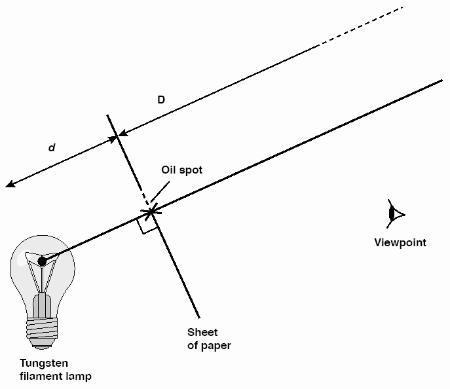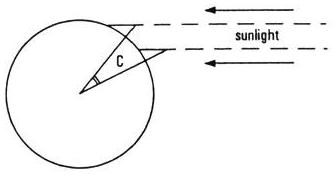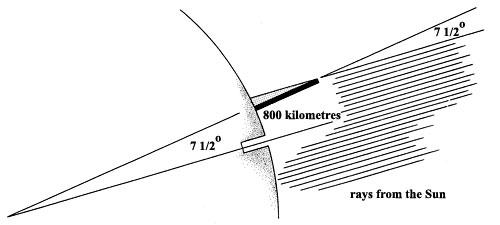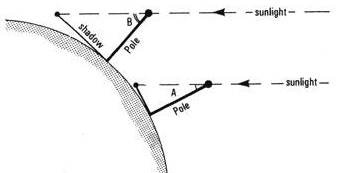Orwell Astronomical Society (Ipswich)
BBQs / Picnics
For the third year running, OASI's summer social event was organised as a picnic rather than the traditional BBQ. Despite threatening skies and weather forecasts, the expected rain held off until late evening. In fact, the weather was perfect – a cool breeze whilst we were eating and putting the world to rights, followed by plenty of sunshine to allow use of the solar telescopes.
It was nice to see so many members and partners, especially Jen Richmond-Hardy.
During the afternoon, Paul Whiting undertook two solar science experiments, repeating those carried out at the 2014 picnic (see below for details). One experiment estimated the luminosity of the Sun; the other the radius of the Earth.
Experiment 1: Luminosity of the Sun
This time, a 60 W light bulb was used, rather than 100 W as previously. Nicki Richards and Paul found the grease spot to become invisible at a distance from the bulb of 7.5 cm. This gave an estimate of the solar luminosity of 2.4x1026 W, compared to the accepted value of 3.9x1026 W.
Experiment 2: Radius of the Earth
Edinburgh Observatory was used as the site for the simulated estimate of the length of the shadow cast by a pole. The estimate of the radius of the Earth was 8845 km, compared to the accepted average figure of 6371 km.
Unfortunately, neither result was as good as those obtained in 2014. The experiments were conducted when the Sun was rather weak, making precise measurements difficult. Never mind, we can try again!
After the experiments, the afternoon developed into a glorious evening, and members were loath to move indoors for the evening entertainment. Those who did enjoyed a quiz, which included some tricky astronomical questions.
It was a very successful event. Thanks to Pete & Nicky Richards for the organisation. Photos by Martin Cook.
Andy Gibbs, Paul Whiting, FRAS
For the second year running, OASI's summer social event was organised as a picnic rather than the traditional BBQ. The event was blessed with glorious weather and attendees enjoyed views of an active sun through a variety of solar telescopes. Thanks are due to Pete and Nicky Richards for organising the event. Photo by Martin Cook.
Andy Gibbs
The OASI 2021 summer BBQ was somewhat unusual, due to social distancing rules! The event was organised as a picnic rather than the traditional BBQ and, of course, attendees had to comply with HMG regulations regarding Covid-19. Nevertheless, the weather was good and, after a year of reduced social interaction, all who attended enjoyed the event. Attendees were: Bill Barton, Martin & Judith Cook, Andy & Mandy Gibbs, Roy Gooding, Mike & Pat O'Mahony, Neil & Lynne Morley, Pete & Nicky Richards, Martin Richmond-Hardy, Dave & Barbara Robinson, Dawn Rose, Alan Smith, John Wainwright, Paul Whiting.
Pete Richards
Our 2019 BBQ enjoyed superb weather, with temperatures reaching almost 30° C!
Martin Richmond-Hardy
We enjoyed a fantastic BBQ at Newbourne Village Hall today, with so many things happening. Before the BBQ proper, Martin Richmond-Hardy and Nicky and Pete Richards helped clear the undergrowth and tree branches from the proposed site, next to the hall, for our storage container. Mike Whybray then disposed of all the trimmings. Thanks to the hard work of the four, the site for the container has taken a big step forward.
Then the BBQ itself. Thanks to Martin Cook for the cooking equipment, and to him, Alan Smith and John Wainwright for "ballistic" entertainment. The high-pressure water-launched rockets were real crow scarers! Thanks also to all who presented feedback on the Chairman’s Summer Challenge (see below for Challenge topics). Finally, it was great to see so many telescopes providing fantastic views of the Sun (still featureless), Venus, Jupiter and Saturn. Mars was too late rising for us!
Photos below are as follows:
Topics for the Chairman's Summer Challenge were based on observational tasks that are part of the Astronomy GCSE syllabus as follows:
Paul Whiting, FRAS
The 2016 BBQ benefitted from a hot, sunny day. Following the food, in line with recent practice, there were various engineering endeavours. Martin Cook, inspired by the OASI astronomy workshop on Rocketry on 09 June by Rod Stevenson of East Anglian Rocketry Society, had developed a fizzy-drink bottle "rocket" launcher, powered by compressed air. In the interests of science, experimentation was required to determine the height of trajectory versus air pressure. A pressure of 13.1 bar worked well, but 15.0 bar was too much! See the video below.
After the engineering experiments, Paul Whiting gave an interesting talk on gAstronomy, specifically oriental cooking. OASI Trustee David Payne then proved to be champion in a quick game of bingo! Finally, everybody moved outside for brief views of the Moon, Mars, Saturn and Jupiter before the mosquitoes won the day and drove everyone to leave.
Launch! Pressure 13.1 bar.
Martin Richmond-Hardy
The 2015 BBQ benefitted from a hot, sunny day. Members of OASI were able to put the Sun's rays to use as follows:
In addition to experimentation based on sunlight, the customary extreme exothermic chemical reactions were created, with everyone standing at a safe distance. The day concluded with the traditional quiz, with Paul Whiting as quiz-master. A great day out was enjoyed by all!
Photographs below are by Martin Cook, Kev Fulcher, David Murton, Mike O'Mahony and Martin Richmond-Hardy. The table-top telescope below is Bill Barton's Questar 3.5, 89 mm catadioptric telescope fitted with a Thousand Oaks solar filter to give a white light image. Three groups of sunspots were visible on the solar disk. When the haze lifted, Bill swung the telescope round and was able to show a few lucky members the narrow crescent of Venus before clouds rolled in. Images of the solar disk below were obtained by David Murton using a Coronado PST and QYH5L II camera.
James Appleton
Scientific activities at the annual OASI BBQ usually centre around solar telescopes of differing types and capabilities, often Hα instruments, only rarely Ca-K (unfortunately!), white light filters and projection techniques of all sorts. However, throughout 2014, OASI hosted many solar astronomy events, so something different was called for: time to recreate great experiments of yesteryear!

Figure 1.
The first experiment was an attempt to measure the luminosity of the Sun by comparing it to that of an electric light bulb of known wattage. Colonel Tomline's professional astronomer, John Isaac Plummer used a similar technique in 1876 to compare the luminosity of Venus to that of a candle.
See figure 1. Make a grease spot of approximate diameter 5 mm on a sheet of white paper. Illuminate one side of the spot by the light bulb, in our case 100 W. Let the Sun illuminate the other side. Adjust the distance between light bulb and the spot until the latter becomes almost invisible, that is, is equally illuminated on both sides. Measure the distance from the spot to the filament of the lamp. The picture below shows Abi Lee and me making this measurement: 7.5 cm.
The analysis is based on the inverse square law, which states that the luminosity per unit area at a distance r from an object of total luminosity L0 is given by Lr = L0/4πr2. So, at the point where the grease spot disappears, Lsun / 4πD2 = Lbulb / 4πd2 where D is the distance to the Sun and d is the measured distance between the spot and the bulb filament. Rearranging and substituting values gives Lsun = 100 (1.5 x 1011 / 0.075)2 = 4.0 x 1026 W, close to the accepted value of 3.90 x 1026 W.

Figure 2.
The second experiment was based on a measurement first performed in 235 BC by Eratosthenes. By comparing the lengths of shadows at distant sites, he was able to estimate the radius of the Earth. Unfortunately we had only one observation site and so had to rely on a simulation at a fictitious second site.
The approach is to measure the length of a shadow cast by a pole at the same moment at two observing sites of known N-S separation (figure 2). Eratosthenes used the time when the shadows were shortest to synchronise the measurement at the two stations. At one of the stations, he placed the pole down a well, enabling him to measure accurately the length of the shadow when shortest (figure 3).
The analysis is as follows (figure 4). Let the radius of the Earth be RE. Let the two stations be I and II, separated by distance D.
Let tan A = shadow length I / pole length I and
let tan B = shadow length II / pole length II.
Then if C = B – A, RE ≈ D / sin C.
Our simulation provided a value of the Earth’s radius of 6414 km, satisfyingly close to the accepted average figure of 6371 km.

Figure 3.

Figure 4.
Now from physics to chemistry. Will the safety officer please leave the field! DO NOT TRY THIS AT HOME.
Pete and Nicky Richards started proceedings by mixing baking powder (sodium bicarbonate) with vinegar (acetic acid) to produce carbon dioxide. The chemistry:
NaHCO3 + CH3COOH → CO2 + H2O + Na+ + CH3COO-.
Now, at a safe distance, Martin Cook and Kevin Fulcher started a production line of Hydrogen, using a concoction of sodium hydroxide and copious amounts of aluminium foil. At least they realised that this is an extreme exothermic reaction and so utilised a sparkling wine bottle in a water bath as a makeshift pressure vessel and cooling system! The chemistry:
2Al + 2NaOH + 6H2O → 2NA+ + 2[Al(OH)4]- + 3H2.
Having mastered the production process, we began to fill balloons with the gases. We noted the following results:
Photos of the BBQ, in sequence. Martin Cook: Paul and Abi estimating the brightness of the Sun by the "oil spot" method. Martin Richmond-Hardy: capturing Hydrogen gas in a balloon. Martin Cook: igniting a Hydrogen-filled balloon. Martin Richmond-Hardy: general view and solar observing. David Murton: spectacular sunset sky after the BBQ.
Paul Whiting, FRAS
Photographs by Steve Shapland.
Photos of the BBQ by Martin Cook and Carol Spicer and of the later quiz by Martin Richmond-Hardy.
All who attended the OASI 2010 barbecue at Newbourne had a great time, due to the excellent viewing conditions and weather - not too hot, not too cold - plus the chance to relax in the company of members who are not necessarily able to attend evening events. Although lighting-up time was not until 2.00pm, members started arriving more than an hour earlier. Many brought along prizes for the raffle, an important fund raiser this year, as there was no charge for entry.
Chairman Neil Morley and his wife Lyn had to depart shortly after arriving, as they were doing a gig in Bury St Edmunds later in the evening. Their departure heralded the end of a game of football and the commencement of some serious solar observing. Throughout the afternoon our Hα telescope was the focal point of attention, being used by all there to admire the half dozen solar prominences on a very active Sun.
The food was almost of secondary importance, as we were rushed through our cooking and eating by Paul Whiting, who had to dash off to London Heathrow to connect with his flight to Melbourne, Australia, at 6.00pm! After eating, four teams assembled in the Hall for two hours of fun trivia, the prize eventually being won by the appropriately named Star Gazers team. This was followed by the raffle and the sudden exodus of our Treasurer...!
I stayed until 7.00pm, leaving behind a tight core of a dozen enthusiastic members: alas, their plans for observing were foiled by cloud cover, although a spectacular sunset was enjoyed by all remaining.
With temperatures still in the low 20s °C, a September barbecue may well become a regular event in the OASI calendar. However, plans for holding it at this time of year rather than in midsummer (to avoid clashing with people's holidays) were foiled as Jimmy's Farm were celebrating their harvest with a music festival, and so a few members went there instead... To paraphrase Abraham Lincoln, you cannot please all the people all of the time.
Many thanks so those who helped organise the event and supplied equipment, food and prizes for the raffle.
Photos by Neil Morley.
Tina Hammond
For this year's OASI summer barbecue we returned to Newbourne Village Hall, the same venue as last year. The event was well attended, helped I'm sure by the late arrival of the predicted "barbecue summer". A weather station in Newbourne - on the www.wunderground.com network - recorded a temperature peak of 27°C during the day.
The afternoon started with the popular outdoor game of gazebo erection, which the strong breeze threatened to turn into a kite flying display and, after a particularly strong gust, parascending! Martin Cook did an excellent job supplying and setting up the barbecue grill. It got rather smoky at one point, but I think this was due mainly to the veggie burgers I overcooked. Said burgers, not being fit for human consumption, or consumption by any living creature to be honest, were added to the coals. The grounds of the hall and the surrounding countryside are very pleasant and with the event starting from 2.00pm and finishing very late there was ample time to try some of the short walks in the area.
During the afternoon, as well as the usual barbecue partying, there was an opportunity to do some observing. We employed two Coronado PST solar telescopes (one belonging to OASI, the other to Paul Whiting) to observe the Sun in Hα light. We used other telescopes to project an image of the Sun. We also spotted Venus.
In advance of the barbeque an invitation was sent to members to present astronomy talks in the early evening, between sunset and it getting dark enough for night-time observing. I'm not sure whether there was a typo in the invite, but Paul Whiting gave us a talk on Chinese gastronomy instead. Actually, to be fair, it was a talk about the food provided on a trip to China to observe the eclipse of 22 July 2009; unfortunately, cloudy skies had limited the scope to report extensively on the eclipse itself! Paul also hosted an excellent quiz. No astronomical expertise was needed; instead, our knowledge of confectionery and TV theme tunes were tested. Notably, it was one of the more recent theme tunes which had our team stumped: clearly we do not need to get out more!
In the evening, clear, dark skies allowed observing to continue, the targets including Jupiter and several deep sky objects. (Telescopes used in the evening included: Bill Barton's 100 mm Vixen refractor; John Wainwright's 200 mm Skywatcher Newtonian reflector on its first outing after a recent conversion to a Dobsonian mount; and the Society's Meade ETX 125 Maksutov-Cassegrain.) The observers spotted several meteors (including one real gem) during an informal watch; the majority were sporadic meteors rather than Perseids.
Thanks are due to everyone who helped make the event a success. The date meant that several regulars couldn't make it this year but with luck we can find a more convenient date next time. Suggestions for next year are welcome.
Photo by Martin Cook.
Pete Richards
Photos by James Appleton.
Photos by James Appleton.
Photos by Martin Cook.
Photos by Martin Cook and Ken Goward.
Just a few words to say what an enjoyable event the 2000 BBQ was, despite there being moments when we wondered if we were in the right season. Shorts were optimistically worn by a few but, by evening, the fleece, and even a blanket, were more in evidence. Thanks to Alan Smith, who again hosted the event on his extensive estate in Grundisburgh. His gourmet skills over the glowing charcoal were wide ranging, including a roast banana, which correctly went black, attracting a few ribald comments.
It was nice to see some of our youngest members there, some of whom took every opportunity to toddle off down the drive hoping their parents weren't looking. Maybe they knew of the millennium celebrations taking place down the road at The Green, and thought that a more enticing event. Other attractions included a raffle organised by our entrepreneurial treasurer. Thanks to those who donated prizes. There were some multiple winners, for one of whom three numbers came up, but with their usual good grace they asked for a re-draw after the first win. Clearly their planetary alignment was different to that of others holding multiple tickets for whom no numbers came up. Unfortunately, the intended first prize was not taken: so the evaporator has to stay in Pete's garage for the next five years! [Nice one, Mike and Sue.] Some enjoyed badminton played to Bristol rules, where the idea is to hit the shuttle at your opponent as hard as possible: body-armour may be beneficial. For those missing the Open Championship, putting was on offer. The game was made difficult by one small boy who thought the idea was to pick up the golf balls and put them in the paddling pool. One young man provided a demonstration of parent abuse: but nothing that the parent didn't deserve. Cloud prevented observation of objects in the sky, but otherwise it was a thoroughly good do. Did I hear Alan say "see you all here again next year?"
Photo by James Appleton.
Ted Sampson
Photos by Alan Smith and James Appleton.